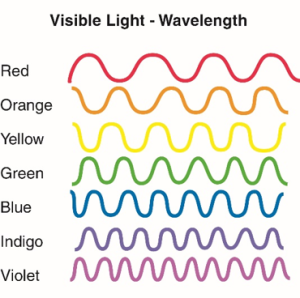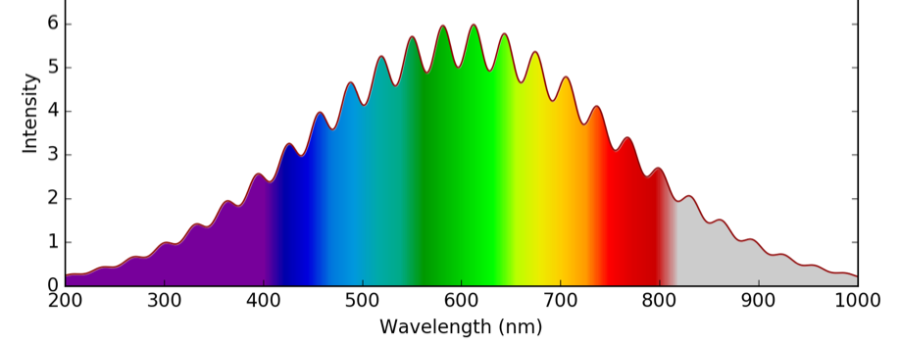One of my favorite things about hiking in Colorado is the assorted colors I encounter: the trees are beautiful greens (or red and yellow in the fall!), the rocks are covered in red and browns, and the sky is a mix of different blues and grays. The sky looks extra beautiful on my hikes, and one thing that strikes me is how different the colors are when you look in different directions. Now, I’m an atmospheric chemist and I know a lot about the sky, but one thing I did not understand was why the sky is so many different colors. Why is the sky light blue in some places, dark blue in others, and sometimes gray? Why isn’t the sky ever green? What about sunrises, sunsets, and rainbows?
I spent some time looking into these questions. And so, without further ado, Science Buffs presents: Colors of the Sky.
–Aroob Abdelhamid
Useful Disclaimer: The light that I am talking about is visible. The sun also gives us infrared light (which we feel as heat) and ultraviolet light (those UV rays that can give you cancer). I’m only talking about the visible light that our eyes are sensitive to.
Part 1: Scattering in the sky
The first question we need to answer is one that most people seem to have asked themselves at least once: why is the sky blue? To understand where that color comes from, we have to understand one major phenomenon: light scattering.
One of the benefits of the sun is that it provides Earth with visible light. Even though it looks white, the ‘color’ white is made up of all the other colors (Figure 1). When light from the sun interacts with our atmosphere and its components, the light separates into its various colors. Depending on how and what the light interacts with, the colors we see change.

Figure 1: A prism can break light into its component colors
As a brief reminder, the colors that make up visible light are red, orange, yellow, green, blue, and violet. All the different colors of light are made up of waves of energy, and each color has a different wavelength, or distance from one peak of its wave to the next peak. Red has the longest wavelength, and violet has the shortest wavelength (Figure 2). We see colors because our eyes are sensitive to these waves of energy. Wavelength is incredibly important because the different wavelengths of light interact differently with the atmosphere, effectively changing the colors we see.

Figure 2: The distance between peaks is called wavelength, and different wavelengths of light make distinct colors
Why is the sky blue?
The sky is blue because of a phenomenon called Rayleigh Scattering. When the white light from the sun interacts with the really small molecules of the air, like nitrogen and oxygen or even dust particles, the light bounces off in such a way that the colors are separated from the original light. Not all of this light is separated equally. More of the shorter wavelengths are split up and “scatter” in other directions, while more of the longer wavelengths don’t split up.
Because atmospheric molecules are the same size as small wavelengths, they scatter shorter wavelengths better. What that means is that the shorter wavelengths, like blue, get split up from the other colors better and so instead of seeing the mixture of all of the colors (as white), you see blue. Those scattered wavelengths are the ones that make it to our eyes when we look up at the sky.
Imagine two sizes of ‘visible light team’ football players trying to tackle a third ‘molecule team’ football player (Figure 4). Because of the difference in size between the two different ‘visible light’ players, the two sizes will interact with the molecule player differently, e.g. they will ‘scatter’ differently. The bigger visible light will barely even notice the small molecule, but the smaller visible light is more likely to bounce off.

Figure 3: Different sizes of wavelengths interact with the molecule differently
Wait, so why isn’t the sky purple?
You may notice that violet and indigo are the shortest visible wavelengths, and should therefore scatter the most to our eyes, but the sky is not purple. What gives? For one thing, there is less violet in the light from the sky than other visible colors. The sun gives off light that has more green and yellow than purple. Further, our eyes are more sensitive to the color blue than purple (Figure 5). If there were no violet/indigo in the sky, the sky would look blue with a slightly green tinge, because of the prevalence of the green scattered light in the atmosphere. However, because of the tiny amount of violet and indigo in the sky, it pushes the blue green color of the sky to a deeper blue.

Figure 5: Our eyes are most sensitive to green and yellow light
Why is the sun yellowish-white?
First off, why are you looking directly at the sun? You really ought not to. You can severely damage your eyes. Stop that.
Though much sunlight is scattered by the atmosphere, some light does not scatter and keeps traveling through the atmosphere, white and unperturbed. That gives the white color of the sun. Of the light that does scatter, remember than not all wavelengths are scattered with the same intensity. More yellow and red stays un-scattered, giving the sun a yellowish tinge.
Why are sunrises and sunsets orange?
Sunsets are orange because the location of the sun in our sky affects how much atmosphere sunlight interacts with before arriving at our eyes (Figure 6). The distance the light travels when the sun is on the horizon is much larger than when the sun is overhead. Thus, more of the light from a sunset is Rayleigh scattered due to the extra atmospheric particles it interacts with.

Figure 6: Sunlight during sunset must travel through more atmosphere and is Rayleigh scattered more.
In fact, there are enough molecules in this longer path through the atmosphere to scatter all of the blue light, so that only the red light remains, and that is what we see. An important thing to note is that if the atmosphere is polluted with a lot of particles (usually from humans!) then more of the light is scattered and the sunset is a deeper and more blended red/orange color, instead of sharp reds and oranges seen in clean air.
What do we know now?
We now know the basics of where colors of the sky come from. Scattering explains such a great proportion of where the colors in the sky come from, but it misses a set of colors that has awed humans for centuries… the rainbow! Tune in for part 2 to find out where that conglomerate of colors comes from and how to make sure you always get the best view of your favorite rainbows.

[…] know from Part 1 that light scattering causes the main colors of the sky, but what does it take to get all of the […]
LikeLike
[…] these questions. And so, without further ado, Science Buffs presents: Colors of the Sky, part 3. (Click here for part 1 and here for part […]
LikeLike
[…] these questions. And so, without further ado, Science Buffs presents: Colors of the Sky, part 4. (Click here for part 1, here for part 2. and here for part […]
LikeLike